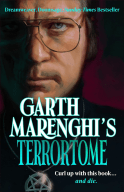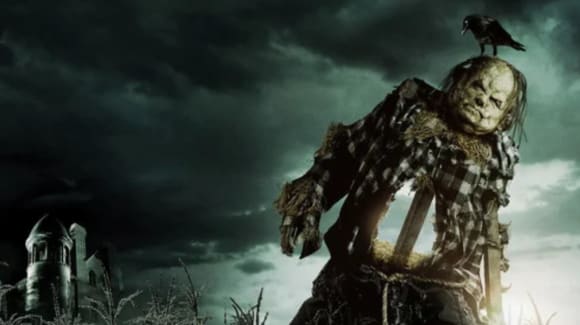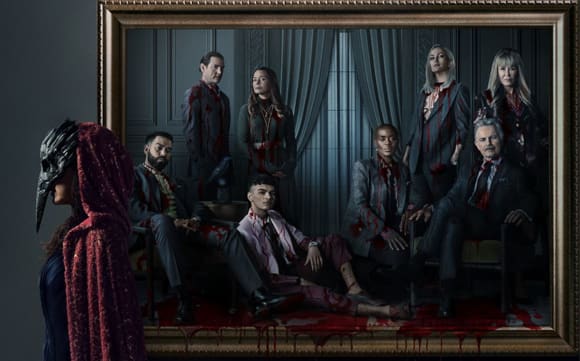
Halloween: Last-Minute Book Recommendations

Otherland, 27.10.2023
Halloween is nigh! You have no idea what to read to get in a spooky mood? The Otherland Bookshop Berlin has some last-minute recommendations for you.
Matthew Holness | Garth Marenghi's TerrorTome
Coronet: 13€
If anyone has ever watched Matthew Holness’ crazy spoof Garth Marenghi’s Dark Place then you already know what is in store for you. Marenghi (penname for Holness) is a hapless, self-deluded dinosaur of a horror author – his works a parody of the kind of tacky, misogynist horror writing and filmmaking which blossomed in the late-twentieth century and inexplicably continues to this day.
Finding the pulse of this strain and stamping on it, TerrorTome has an offbeat, often delirious humor to it (think the comedy work of Matt Berry, Chris Morris, or Julian Barrett…), a knowing send-off of the genre bugbears mixed with nonsensical asides.
The plot in a nutshell: following an illicit and laboriously described love affair with a cursed typewriter, acclaimed horror author Nick Steen comes face to face with the terrifying entity Typeface, Dark Lord of the Prolix. Through their monumental battle, Typeface unleashes the terrors of Steen’s twisted imagination onto the real-world town of Stalkford. Now Steen must defend the town from the denizens of his own best-selling and not-so-best-selling novels, including serial killer and world expert in avascular necrosis Dr Nelson Strain, as well as a series of throppelgangers (think about it) under the banner of the Dark Third. With only the help of Roz Bloom, his “frequently incorrect female editor” (who he often seems to oppose more than the escaped nightmares), Steen has to stop a wave of terror that threatens to destroy Stalkford, outer Stalkford, and possibly slightly further…
Brutally knowing in its targets and frequently laugh-out-loud cringe worthy. This is a very silly parody of bad horror writing and bad horror writers everywhere. And I mean that as a compliment. [Tom]
Zara-Louise Stubbs | The Uncanny Gastronomic
British library: €13
Almost every genre is “haunted by food”, whether it is the lack of it (dystopia), extremes of quality and quantity (fairy tale), dark displays of luxury (gothic), or of the surreal (magic realism). Horror, and particularly the uncanny, uses food even more so – go into your memory-bank for a minute and try to think of all the classic horror scenes which involve eating (or being eaten).
With this in mind, Zara-Louise Stubbs brings together a gruesome menu of literary delights, some old, some new, some familiar, and others obscure. A veritable feast.
Some great highlights in here: I really enjoyed Shirley Jackson’s Like Mother Used to Make, a tale which might be the very definition of uncanny. I don’t want to give too much away, but it starts as a lovely domestic evening between neighbours, and then on a single sentence it turns into something absolutely nightmarish with a very dark streak of humour. And what about Roald Dahl’s Pig. (Did you know he wrote eighteen collections of short stories for adults?) It is the best possible combination of fairytale craziness and that dark, macabre devilry that runs through his children’s stories. This one starts with a couple going to a nightclub the night their son is born, and it goes wickedly downhill from there.
Stubbs has a great time playing with genre expectations. There are your classic short stories here but there are also poems (Robert Browning’s The Laboratory is super), autobiographical essays, and extracts. You might expect to meet Angela Carter, Algernon Blackwood, and Edgar Allan Poe in such a collection, but what about Franz Kafka, Mark Twain, Italo Calvino, or Saki? Suitably dark fare for a dusky, autumnal Berlin evening. [Tom]
Paul Tremblay | The Beast You Are: Stories
Titan Books: €12
The recent movie adaption of The Cabin at the End of the World has hopefully converted a few horror fans to team Tremblay and fingers crossed got them to read the original novel.
Better still would be digging up A Head Full of Ghosts, the writer’s love letter to Shirley Jackson’s We Have Always Lived in the Castle, which might be THE horror novel of our time. His collection Growing Things is also not to be sniffed at, though there are fewer scares to be found there. Tremblay’s last offering, The Pallbearers Club, met with decidedly mixed reviews so I was curious to see how this collection would play out.
Good news first. The Beast You Are is just as inventive at times as Tremblay’s earlier work, though for all the inventiveness, ironically it is the more realistic tales which hit home. “I Know You’re There” is a post-Covid tragedy in which widower Silas loses his husband David but is followed by something more active than a regular corpse. It is both touching and unsettling. Similarly, “The Blog at the End of the World” marries humour and dread in a Memento-style reverse plot that very cleverly uses the stage of online discussion boards (the fact that you read everything backwards chronologically) to address a spate of disappearances, again mirroring those lost over lockdown. “The Last Conversation” meanwhile depicts a man trapped in a strange room and recovering from some unknown affliction. He must piece together his identity through talking to a strange and mysterious woman. It is an intelligent back-and-forth exercise in trust and withheld information, a clever variation on Plato’s cave metaphor.
There are also nods to other horror authors here: a King-style small town America childhood horror (“Haunted House Tour: 1 per Person”), a Jackson-esque social dilemma (“The Party”). The strangest thing about the collection, though, is how few genuine scares there are. Looking down at the adjectives in my notes there is a lot of “humorous”, “odd”, “fun”, and even “sweet” but very little to draw up the levels of fear and unease conjured by Tremblay’s best offerings. And there is a lot of navel-gazing here, with the writer re-hashing old material or stabbing out at critics and reviewers. You have to have read the back catalogue in order to get the gist of “Red Eyes” or “The Postal Zone”. There are also a lot of long sentences, overly-stretched concepts, purposefully obscure word choices, and ambiguity - so much ambiguity. A little of that I can stomach, but 470 pages…
Hardcore Tremblay fans: go for it. Horror nerds will enjoy finding the copious genre references and in-jokes. Fans of weird fiction should grab a copy too, for the originality of some of the tales. Just don’t expect too many sleepless nights. [Tom]
Sadie Hartmann | 101 Horror Books to Read Before You're Murdered
Page Street: €26
“Welcome to modern horror.” What to say about Sadie “Mother Horror” Hartmann’s new horror catalogue, 101 Horror Books to Read Before You’re Murdered? Well, I’ll start with it is an absolute necessity for any horror fans. It is better illustrated than many graphic novels and is a natural eye-catcher. (You’ll all want it on your blood-spattered coffee tables.)
Co-owner of Night Worms, Hartmann is a humorous, humane, and above all honest host – she is really fun to be around and lovingly opinionated about everything, not least the books she left out.
Shying away from the classics, and instead covering everything from the last 23 years, Hartmann’s text divides up its 101 nominees into the paranormal (haunted houses, ghosts, creatures and cryptids), the supernatural (demons, witchcraft, cosmic horror), human monsters (coming of age, grief and death, cults, slashers, body horror, creepy kids, and crime), natural order horror (apocalyptic, dystopian, eco-horror), and the ever-brilliant short stories category. In addition, you’ll find sections with author spotlights – 10 representative talents with multiple works worth reading, from Ania Ahlborn to Tananarive Due, each of whom picks their own favourite texts to add to the mix. And it doesn’t stop there. Hartmann has a quick, at-a-glance reference system, designed to double up as trigger warnings, a glossary of horror terms for newcomers, quizzes and extra reading for zealous fans, and essays from contemporary writers, including Eric Larocca, Hailey Piper, and Cassandra Khaw.
This is a slim volume but a hell of a piece of work. As Josh Malerman points out in his intro, when a book is an all-encompassing bibliography of an entire genre, the required research is thousands of books. A pleasure to read. Just be prepared to want to buy more books. Boy this was a dangerous one for me – my to-read list went up by 18 after the first casual flick through. Now it is sitting on my desk looking all coy. 18 and counting… [Tom]
Alvin Schwartz | Scary Stories to Tell in the Dark: The Complete Collection
Scholastic: €10.5
There is something about collections of ghost stories. They can be both fingernail-bitingly creepy and yet nostalgically cuddly, like the book version of comfort food.
I don’t mean the clever, is-it-just-a-psychological-trick ghost stories. I mean proper campfire howlers. The BBC’s Ghost Story for Christmas renditions of M. R. James and Charles Dickens. Chris Priestley’s Tales of Terror. R. L. Stein’s Goosebumps. To this group you can add Alvin Schwartz’s Scary Stories to Tell in the Dark.
Schwartz’s original books were published in the 80s and 90s, but here all three collections are in one volume, illustrated throughout with Stephen Gammell’s weirdly watery black-and-white images. Taking out the notes and suggested reading, the volume combines some 150-odd pages of short and sweet horror tales, many of them only a page in length. Screaming skulls, walking corpses, dancing bones, poltergeists, sewer rats, spiders’ eggs, narrow escapes and others not so lucky. Many of these tales reflect the nineteenth- and twentieth-century’s tastes in horror: the bizarre wendigo, hook-handed serial killers following dating couples, doomed babysitters and home hauntings. Others are refreshingly odd, such as a woman whose husband turns into an alligator or a spectral wolf getting revenge on a hunter. Above all, theatrics are key to these tales. Schwartz’s collections revel in the How of ghost-storytelling, the way you scare the life out of your friends, children, or parents. Many of the tales even come with instructions to the reader, stage directions to follow while retelling them.
If you come expecting brutal twenty-first-century scares along the lines of the 2019 film adaption you might be disappointed (although many of the film’s critters appear here – “Harold”, “The Red Spot”, and “The Dream” being notable examples). What you will find is an extensive work of antiquarian collection – a sort of Grimms’ Fairy Tales for ghost stories. The tales themselves are designed for younger readers, but for genre fans with an academic mindset a good third of the book is dedicated to Schwartz’s behind-the-scenes research and his comprehensive lists of sources. I had a lot of fun with this one, and for all that it’s aimed at kids, it had a few tales that genuinely creeped me out. Sit down with this one for Halloween. [Tom]
B. R. Yeager | Burn You The Fuck Alive
Apocalypse Party: €23,50
It's funny how you feel the need to apologize when a book by an author whose work you previously loved and praised just doesn't hit the mark. I'll try not to do that but, dayum! I loved Negative Space so much, it was even in my top 5 books the year it was first published, and was actually really psyched about Burn You the Fuck Alive, I mean, that title alone... And it didn't hit that mark, sorry.
Still, in this first collection of short stories by the author, I found crumbs here of what mesmerized me in Yeager's former work – vulnerable characters, a menacing atmosphere, beautiful writing. Only, they were just crumbs and if I have to be honest, I didn't know how to place these stories, what to make of them, let alone enjoy them. There are illustrations and photo-art in between the stories, sometimes they are the story itself. And the written in text stories cover a range from body horror to a rather “American” kind of horror with lots of gun violence and psychologically fucked up characters. All in all, this whole book feels like a soup, a mushroom soup.
So, not really burnt the fuck alive, but that's OK. Next time, maybe. [Inci]
Philip Fracassi | Boys in the Valley
Orbit: €13
The date is 1905, at St. Vincent’s Orphanage for Boys, Harris Valley, Pennsylvania. Peter Barlow - orphaned at a young age by a brutal murder - is now one of the older boys, and struggles between Father Andrew’s desires for him to become a priest and his romantic feelings for local girl Grace Hill. Peter doubts his own faith, and fears a dark aspect of his own character.
Then one night the local sheriff and his men show up with a badly wounded prisoner, screaming and covered in odd markings. With his death, something is unleashed on the orphanage. Soon boys start acting strangely, going missing, and worse.
Boys in The Valley was released for a very limited readership in 2021 and is now finally available in mass paperback with a bleak, near-white cover. A coming-of-age horror on demonic possession, the dark side of religious practices, and child abuse. Think Oliver Twist meets The Exorcist. In Mark, chapter 5, Jesus exorcises a possessed man and the ousted demon divides itself between a herd of two thousand pigs, which then throw themselves off a cliff. Fracassi’s book asks: What would have happened if there were no pigs? It’s bleak, blood-soaked, and Stephen-King-esque. Numerous reviewers have mentioned links to William Holding’s Lord of the Flies, or the 2021 Netflix series Midnight Mass, both in the assembly of seemingly innocent characters who descend into an unholy chaos through a combination of environmental pressure and outside influence, and in that all addresses fundamental questions of sin. I was also reminded of Solzhenitsyn’s One Day in the Life of Ivan Denisovich, for the day-to-day purgatory of life in the orphanage with its authoritarian overseers, punishment pits, bitter rivalries, and sheer hunger. ‘When you’re hungry, goodness is forgotten until you’re not’, notes Peter.
Aaargh, this was so good! One to read again and again and again. Fracassi does an excellent job with his cast of castaways, in a monotonous setting where there was a real danger of all the boys melding into one. Peter, on the cusp of graduating to the real world, has something of that horror stalwart of the old cop who is retiring tomorrow but will take one more case just for old times’ sake. The other boys are equally well thought out, particularly David and Bartholomew. We grow so attached to these boys that the horror, when it hits, hits hard. I had to close the book and look around me a few times. And yet despite this, Fracassi’s book is a stage for some deep acts of heroism, self-understanding, and hope. How these boys choose to act and how (or if) they come out of the nightmare matters. St. Vincent’s becomes the site of a monumental struggle between good and evil, and it will stay in your mind long after you’ve read the final page. [Tom]
Ray Celestin | Palace of Shadows
Pan Macmillan: €22.50
If you like books more for their text and plot than their subtext, then Palace of Shadows might be the spooky novel for you. It’s an almost by-the-book gothic story that takes place near the end of the Victorian era, taking place in the ever-fascinating Yorkshire moors (thank you for that, Brontë sisters and less famous brother), dripping with atmosphere, howling winds, spiritualists and disturbing colonial views.
The main character Sam Etherstone is an artist disgraced by his proximity to Oscar Wilde and his ‘gross indecency’ scandal. And so, he’s vulnerable to being roped into the commission of a lifetime: working on a house in Yorkshire, a house that’s more of a labyrinth expanded continuously for the past 50 years. His boss is Mrs. Chesterfield, the owner of an industrial empire that manufactures weapons and other things, such as poison. The house is pretty vividly described on the page and drenched in mystery (of course).
Author Ray Celestin throws a lot of tantalizing ideas in the air – the perspectives on madness in that era (and any era, for that matter), the way the war machine is constantly fed by weapons manufacturers and also the fate of creators and artists –, but the subtext on those feels muddled and without follow through. The characters also feel rather flat and the narration has a detached quality that is definitely not my thing, especially in a spooky context. [Ruxandra]
Jordan Peele | Out There Screaming
Pan Macmillan: €26
A spurned woman receives sinister messages from her ex’s new lover; a crooked cop begins seeing disembodied eyeballs pointing out minor sins of road users; a free black community entreats dark forces to protect them from Klan attackers; and four white boys try to hammer out what it means to play the villain, and what it means to be played.
Jordan Peele is probably known to you already as the visionary mind behind modern horror classics Get Out and Us, as well as the 2019 resurrection of The Twilight Zone. Here the comedian and horror connoisseur turns his hands to curating a collection of horror short stories from contemporary black writers.
What a feast. Normally with horror collections you have to wade through a lot of detritus to get to the good stuff, but I can honestly say that the lion’s share of these were great, with the genre focus swinging between horror, weird fiction, and experimental sci-fi in an enjoyable way, much like The Twilight Zone. One of the most arresting things about the overall focus of the collection is that it’s the stabs of realism that are the scariest: the rampant racism, casual discrimination, stereotyping, and subliminal (and often very blatant) hostility faced by the wide pantheon of black characters.
For experienced readers there is a whole host of recognizable writers here at the top of their game. P. Djèjí Clark’s “Hide and Seek” tells of two brothers – Jacob and Jamie – who endlessly practice hide and seek drills in their dilapidated mansion, fearing the day they’ll have to use it against their own family’s dark magic. A grieving daughter travels all the way from the US to Nigeria for her father’s funeral in Nnedi Okorafor’s “Dark Home”, but when she stands in the way of old folk traditions, she ends up bringing home the wrath of a secret society and an ancient demonic being that litters dust storms and cowrie shells in its wake. Meanwhile N. K. Jemisin shines in the deeply disturbing opening tale “Reckless Eyeballing”, which pairs despicable policing tactics with a supernatural form of surveillance software.
Of the nineteen tales it was genuinely tricky to pick a favourite. I really enjoyed Nicole D. Sconiers’ “A Bird Sings by the Etching Tree”, in which Del and Amber, two young female ghosts from traffic accidents, haunt a lonely stretch of the highway, exacting a bloody revenge on the type of drunk, irresponsible males who put them there in the first place. I also found myself drawn into Terence Taylor’s “Your Happy Place”, where prison guard Martin finds his perfect life troubled by alarming secret projects going on in the restricted wings at work. Why does he have to escort so many inmates down there? What happens to them when they go through those doors? And why do so few of them return? From the segregated South of the 1800s to the near future of AI tech and compassionate androids, Out There Screaming shines a dim torchlight on the many unrecorded horrors of black life swept to the edges of the records. It’s an impressive torchbearer for a new contingency of horror writers. [Tom]














